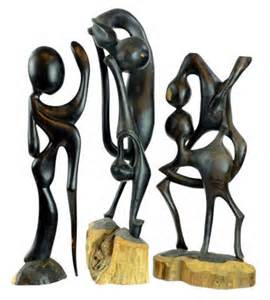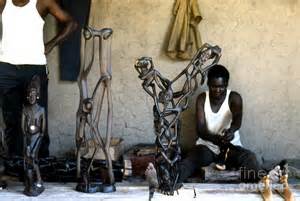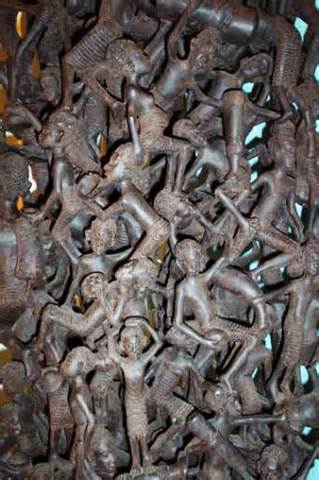
http://en.wikipedia.org/wiki/Adansonia
The Baobab Tree
An overview of the Boabab tree, its natural history, uses and legends of the unique trees native to Madagascar and Northern Australia.
Boabs are fat-trunked trees that are native only to Madagascar and North-Western Australia. They have been known to attain girths of almost 30m, with a diameter of about 9-10m. It is thought that boabs live up to 2,000 – 6,000 years.
Australian Boabs
In the North Australian ‘Wet Season’, the boab has a dense coverage of bright green leaves. In the ‘Dry’ season (winter) the Boab drops all its leaves, and looks a like a tree that has been planted with its roots in the air.
Australian Aboriginal legends reflect this: The Boab was once a graceful, proud tree that delighted in boasting about its beauty to the other not-so-graceful plants that inhabited the same area. They complained, and God made it so that the seeds of the boab sprouted upside down – so the roots grew upwards, and the branches down into the earth.
Similarly, an Arabian legend says of the Madagascan boabs (known as Baobabs), “…the devil plucked up the baobab, thrust its branches into the earth, and left its roots in the air.” (Encyclopedia Brittanica)
It has been speculated that the Australian Boabs may have originated from seed pods carried for food by seafarers from Madagascar or Africa.
Towards the beginning of the ‘Wet Season’, the Boab begins to flower. Large white to cream, waxy, sweet-scented, ‘candle-like’ flowers cover the tree. These are pollinated at night time by large moths. The flowers develop into large oval or roundish seed pods.
Unusual
One particularly unusual trait of the Boab is it’s ‘portability’. These hardy trees can be successfully transplanted with no special care taken. When roads in the Shire of Wyndham-East Kimberley were widened several years ago, the boabs were plucked from the ground, transported dozens of kilometres laying on the bed of a truck, then deposited on the ground at the Wyndham Port where they lay for several weeks. They were then re-planted at the Port and continue to thrive, looking as though they have always been there.
Bounteous Tree
The Boab has been a bounteous tree to the Aboriginal people. Almost every part of the tree is used in one way or another.
The seed pods have a woody casing with a velvety covering that is scraped off to create artwork on the pod. The seed kernels are eaten raw or roasted, and are a highly nutritious food source.
Leaves and roots are used for medicinal purposes, primarily gastric and chest complaints. The Boab’s bark is used to make string, rope and twine, and the gum of the tree can be used as glue.
The trunk stores water, and it has been estimated that up to 120,000 litres of water may be stored by one tree.
Additionally, Boabs can be used for shelter, as they develop hollow trunks. A hole is carved in the trunk to form a door, the soft pulp removed and a fire lit inside to dry out the hollow. The bark grows around the cut and over the internal surface of the tree, which is unharmed by the excavation.
In the early Kimberley pioneering days, Boabs were often temporarily used in this way to contain prisoners. Grates were fitted to the openings, the prisoners put inside and the grate locked.
Twenty kilometres from Wyndham is the Prison Tree, which still bears bolts and studs from its service as a prison. There is also a Prison Tree near Derby, 900km away. It is likely there were others throughout the Kimberley region.
Madagascan Baobabs
In Madagascar and Africa the Baobabs are similarly used in regards to food, resources and medicinal uses, but they also feature largely in fertility rites and ancestor respect rituals. In Senegal they are sometimes used to contain the remains of Griots – guardians of community heritage, similar to Tribal Elders in Australian Aboriginal society.
A sacred Baobab in the village of Toumbou-Ba contains an altar of sorts. The Baobab has a long and intricate history, and is regarded as a protector. A famous ancestor is buried under the tree, and it is considered to be a refuge. A person under or inside the tree cannot be hit or abused by others.
This sacred Baobab is also to be considered an aid to fertility. Infertile women place their hands on the tree and promise to either offer sacrifice, or the naming of their child after the tree in return for fertility. Breaking the promise results in the death of the child.
Domestic Cultivation
The Boab or Baobab grows very easily from seed, and is prized in bonsai circles. If kept in pots, they must not be watered once they enter their dormant state each year, or the excess moisture destroys their roots. They can in fact be removed from the pot, the roots shaken free of soil and the tree stored until they begin to come out of dormancy, when they are repotted.
They need a warm environment, being very cold intolerant, and in many parts of the world will need to be cultivated as indoor plants.
Among the first wave of immigrants to the New World was an English Puritan named John Endicott, who in 1629, arrived to serve as the first governor of the Massachusetts Bay Colony. Charged with the task of establishing a welcoming setting for new arrivals upon the untamed land, the Pilgrim leader set about making the area around modern-day Salem as homey as possible.
In approximately 1630, as his children watched on, Endicott planted one of the first fruit trees to be cultivated in America: a pear sapling imported from across the Atlantic. He is said to have declared at the time: “I hope the tree will love the soil of the old world and no doubt when we have gone the tree will still be alive.”
This isn’t finished. But it will be. Two residential towers, dense with trees, will have their official opening later this year in downtown Milan, Italy, near the Porta Garibaldi railroad station. (The image is not a photograph, but an architect’s rendering. The towers are built and the trees are going in right now.) I love this. I think these towers are gorgeous. Milan is a very polluted town; these trees will cleanse the air, pumping out oxygen and greening the cityscape. I think cities one day could look like mountain vistas; I’m enthralled.
April 19, 2013 9:25 AM
Trees Come ‘From Out Of The Air,’ Said Nobel Laureate Richard Feynman. Really?
September 25, 201212:05 PM
Ask one of the greatest scientists of the 20th century a simple question, and his answer makes me go, “What? What did he just say?”
The question was: Where do trees come from?
(YouTube)
Meaning, when you see a tree, a big, tall, heavy one, and you wonder where did it get its mass, its thick trunk, its branches — the instinctive answer would be from the soil below, plus a little water (and, in some mysterious way, sunshine), right?
Nope, says the late Nobel laureate Richard Feynman, sitting in an easy chair, thinking out loud in a You Tube video clip from 1983: “People look at a tree and think it comes out of the ground, that plants grow out of the ground, ” he says, but “if you ask, where does the substance [of the tree] come from? You find out … trees come out of the air!”
From the air? Trees are hard, branchy, heavy, covered with bark. They don’t precipitate out of air. This sounds like sorcery, not science.
But then Feynman says it again, “They surely … come out of the air.”
If you are wondering how tons of wood, leaf, bark and all the innards of, say, a massive redwood tree can get pulled out of air, you’ll want to hear Feynman’s explanation, which is mostly him happily arguing with himself. (“How is it the tree is so smart … and do that so easily? Ah! Life! Life has some mysterious force? No! …”)
But First…
But before you go to Feynman, it’s best to start here, with this primer from Derek Miller of Australia’s science video site, Veritasium. “Would it surprise you,” Derek asks three young guys in a park — one of them wearing a T-shirt that says “living the dreem,” “to discover that 95 percent of a tree is actually from carbon dioxide, that trees are largely made up of air?” The guys smile politely and say, “Ummmm … OK … ”
I think, watching this video, you’ll be more surprised than they were.
(YouTube)
So that’s the lesson: that a tree gets its mass from air and water. It “eats” air, chomps down on airborne carbon dioxide, then uses sunshine to pull the carbon dioxide apart, gets rid of the oxygen, which “it spits back into the air,” says Feynman, “leaving the carbon and water, the stuff to make the substance of the tree.”
But wait a second! Water is in the ground, right? Water is not in the air. Ah, says Feynman, but how did water get into the ground? “It came mostly out of the air, didn’t it?” Waving his hands, he says rain “came out of the sky.”
What a beautiful notion, that from the dancing air comes the towering monarchs that are our trees. But don’t take my word for it, or Derek’s. You’re now ready to hear it from the Big Guy. When this begins, he’s talking about fire. He gets to trees about two minutes in.
Sowing The Seeds For A Great American Chestnut Comeback
by Helen Thompson, December 14, 2012
Michigan growers harvest ‘Colossal’ chestnuts, like the one above in New Paltz, N.Y. “If you’re going to work in the kitchen with a pound of chestnut, [the] largest best tasting chestnut you can find is the one you want to use,” says MSU plant pathologist Dennis Fulbright.
Lee Reich/AP
Though we hear about them every holiday season in that famous song, chestnuts – whether roasting on an open fire or otherwise – have been noticeably absent from many American tables for decades, thanks to a deadly fungus that decimated the species near half a century ago. But a small army of determined growers have been on a seemingly quixotic quest to put chestnuts back on the American table, and they’re just starting to see results.
“There’s a steady and consistent growth, in the number of growers, the number of acres, and the number of people who are buying chestnuts,” says Michael Gold, a forestry professor at the University of Missouri’s Center for Agroforestry. That’s a little bit to do with America’s bustling foodie culture. Growers are branding the chestnut as a health food, and are more poised to handle the ecological pitfalls of the past.
First, here’s a little history on why the giant American chestnut – once a steady nut producer for humans and animals alike – virtually disappeared. In 1904, scientists noticed odd rusty cankers on northeastern chestnuts. The culprit: a fungus called Cryphonectria parasitica or “chestnut blight”. They tried to stop the blight with fungicides, breeding American trees with naturally resistant Asian varieties, and even nuclear radiation, with no luck. So, by 1940 – it had left approximately 3.5 billion dead or dying chestnuts in its wake. (The American Chestnut Foundation is still hard at work at developing a resistant Asian/American hybrid).
In the early 1900s, two men stand amid five American chestnut trees near Townsend, Tenn. Once called “the Redwoods of the East”, chestnuts made up 25 percent of Northeastern American forests. HO/AP
In the early 1900s, two men stand amid five American chestnut trees near Townsend, Tenn. Once called “the Redwoods of the East”, chestnuts made up 25 percent of Northeastern American forests.
HO/AP
Now, of course one can still find chestnut vendors selling funnels of roasted nuts in cities like New York. But they are largely imported. “You can still find them in Europe and Asia because they never left those places,” says Dennis Fulbright, a plant pathologist at Michigan State University who advises a Michigan grower cooperative called Chestnut Growers, Inc. Chinese chestnuts strongly resist the blight, while European chestnuts have enough resistance to survive a blight infection. They still have to worry about blight in European trees, but a virus that essentially gives the fungus a cold has allowed growers to treat individual trees successfully.
Fulbright attributes some of the nut’s resurgent popularity to the simple fact that it’s healthy. “It’s low in fat; it’s gluten free,” says Fulbright. “People discovered that it’s probably one of the best foods on the planet – from the Roman legion to resistance fighters in Europe during WWII.”
- S. chestnut imports have held steady around 4,000 metric tons, with creeping increases in the last ten years. If you’re on the west coast, it’s likely the chestnuts you’re buying are a Chinese or Japanese species from China or South Korea, and if you’re on the east coast, you’re likely purchasing European chestnuts from Italy or Turkey.
But, you don’t have to live a coastal urban metropolis to enjoy chestnuts. Thanks to increasing numbers of U.S. growers cultivating hybrid and foreign varieties, roasted chestnuts are reappearing at holiday festivals and in local supermarkets in the middle of the country, too. “They’re now in small town America,” says Fulbright. Michigan leads with around 200 growers, followed by Oregon and California.
Michigan growers plant a cold climate friendly European/Japanese hybrid called ‘Colossal’, while other states like Missouri grow Chinese chestnuts. European and hard-to-find American chestnuts are slightly sweeter than Chinese varieties, but Fulbright says, “most species of chestnut taste about the same by the time you could use them in a culinary dish.” (Here’s a how-to guide on cooking chestnuts.)
Many growers hand harvest to serve a niche, regional market, but they hope to modernize with grabbing tools called nut wizards and vacuum and all-in-one self-propelling harvesting systems. On the processing side, anti-microbial treatments help improve chestnut’s short shelf life. “It’s like an apple, if you leave them on a table they’ll go crummy,” says Dan Guyer, an engineer at MSU who’s experimenting with X-ray chestnut sorting technology.
And then there are new marketing strategies. Chestnut flour is aimed at the gluten free crowd, but there’s also chestnut honey and beer. MSU helped develop peeled-frozen chestnut packs, hoping to appeal to the shopper on the go.
In Missouri, Gold likens it to selling a novel exotic fruit in U.S. markets for the first time: “We see our role as the catalyst in developing what we call the ‘new’ chestnut, as a new crop for American palates.”
But, U.S.-grown chestnuts now face another set of threats – some that have been around, like root rot fungus, and some new imports, like the Asian gall wasp. Fulbright says that growers are already taking defensive steps. “I’m optimistic,” he says. Hopefully, this time around chestnuts will be here to stay.
The Oldest Trees on Earth
Ever wonder what the age of the oldest tree in the world is? Hundreds of years old? Thousands? Or maybe even hundreds of thousands of years old?
As with most natural living things on this earth, there’s some debate about exactly which tree is deemed to be the oldest. Regardless of the debate, here’s a list of some quite special (and old) trees/bushes:
- UPDATE 20 April, 2008: Since posting this article, a new discovery has been made in Sweden. A tenacious spruce tree with a root system 9,550 years old.
- The most likely contender at this stage is a tree that goes by the name of “Methuselah“. According to the Guinness Book of World Records, Methuselah, would now be 4,769 years old. Methuselah is a Bristlecone Pine located in the Ancient Bristlecone Pine Forest in the White Mountains of California. Methuselah isn’t the only “oldie” in this forest. The other Bristlecone Pines in this forest are all over 4,000 years old too!
- A tree called Prometheus (also known as WPN-114) was thought to be around 4,900 years old (some reports claim 5,000 years old – until it was cut down for research purposes in 1964. Prometheus, also a Bristlecone Pine, grew at Wheeler in eastern Nevada, USA.
- A creosote bush called “King Clone” in the Mojave Desert is said to be 11,700 years old.
- In 2005, it was thought that another creosote bush in Palm Springs could be older than King Clone – as much as 20,000 years old. I’m not sure if this report was confirmed or not.
- In 1995, an extraordinary Huon pine tree was found in Tasmania, Australia. What was thought to be many trees covering 2.5 acres, appeared to be just one tree – a very old tree. Some media reports claimed it could be 30,000 to 40,000 years old. Scientists weren’t confirming this, but said that it was plausible that the trees could actually be one very old, underground tree.
- And… not exactly a living tree, but last year, scientists claimed to have found what could be the world’s oldest tree – in the form of a fossil. The tree, called Wattieza would have lived around 385 – 397 million years ago.
Tags: australia, california, tasmania, tree, world records
Related Posts:





Published: Jul 11, 2015
Latest Revision: Jul 27, 2015
Ourboox Unique Identifier: OB-62592
Copyright © 2015








